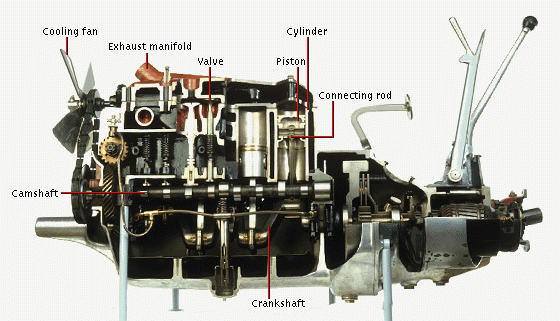



INTRODUCTION
The internal combustion engine is a rich source
of examples of almost every conceivable type of
heat transfer. There are a wide range of
temperatures and heat fluxes in the various
components of the internal combustion engine.
Internal combustion engines come in many sizes,
from small model airplane engines with a 0.25 "
(6 mm) bore and stroke to large stationary engines
with a 12" (300 mm)
About 25 % of the air/fuel mixture energy is
converted to work, and the remaining 75% must
be transferred from the engine to the
environment. The heat transfer paths are many,
and include many different modes of heat transfer.
In this module, we will discuss the heat transfer
processes in the engine components, then consider
the engine parameters and variables which affect
the heat transfer processes. We present various
models of the heat transfer processes,
and example calculations of the heat transfer
rates and coefficients. Once you have explored
the core sections, you can also go to the
advanced sections, where current research
topics and problems are presented.
One of the most important inventions of the
mid- to late 1800s, the internal-combustion
engine generated mechanical energy by burning
fuel in a combustion chamber. The introduction
of the new engine led almost immediately to
the development of the automobile, which had
been largely unfeasible with the unwieldy steam
engine. Shown here is a 1925 Morris engine,
the basic unit for a family car. It features
four in-line cylinders with aluminum pistons.
The valves are opened by push rods operated by
a camshaft and closed by springs. Power is
transmitted by means of the crankshaft to the
gearbox.

MORE INFORMATION ABOUT THE INTERNAL COMBUSTION
ENGINE

The ordinary Otto-cycle engine is a four-stroke
engine; that is, in a complete power cycle, its
pistons make four strokes, two toward the head
(closed head) of the cylinder and two away from
the head. During the first stroke of the cycle,
the piston moves away from the cylinder head
while simultaneously the intake valve is opened.
The motion of the piston during this stroke sucks
a quantity of a fuel and air mixture into the
combustion chamber. During the next stroke, the
piston moves toward the cylinder head and
compresses the fuel mixture in the combustion
chamber. At the moment when the piston reaches
the end of this stroke and the volume of the
combustion chamber is at a minimum, the fuel
mixture is ignited by the spark plug and burns,
expanding and exerting a pressure on the piston,
which is then driven away from the cylinder head
in the third stroke. During the final stroke,
the exhaust valve is opened and the piston moves
toward the cylinder head, driving the exhaust
gases out of the combustion chamber and leaving
the cylinder ready to repeat the cycle.


The efficiency of a modern Otto-cycle engine is
limited by a number of factors, including losses
by cooling and by friction. In general, the
efficiency of such engines is determined by the
compression ratio of the engine. The compression
ratio (the ratio between the maximum and minimum
volumes of the combustion chamber) is usually
about 8 to 1 or 10 to 1 in most modern Otto-cycle
engines. Higher compression ratios, up to about
15 to 1, with a resulting increase of efficiency,
are possible with the use of high-octane antiknock
fuels. The efficiencies of good modern
Otto-cycle engines range between 20 and 25
percent—in other words, only this percentage
of the heat energy of the fuel is transformed
into mechanical energy.

OTHER PHOTOS AND INFORMATION

This Photo shows the chamber of an
engine.

This Image shows a view of the
head of an engine.

Created By
Monica Sanchez
(All Rights Reserved)

IMPORTANCE OF THE INTERNAL COMBUSTION.
I believe that the Internal Combustion Engine is
Very important for the world today because
If we did not have the Internal Combustion Engine
A lot of the cars that we see each day depend
of that Kind of engine. The School Bus that take
me to school Every morning, the car that the
Police use, the Ambulance, The car that all of our
parents use on a daily basis depend Of that kind
of engine. That is why I believe that the Internal
Combustion Engine is very important for me and
for the whole World.
